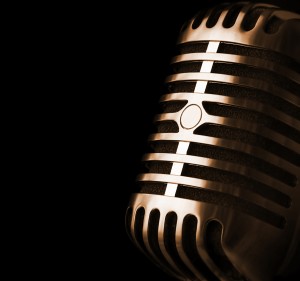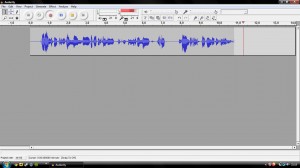So you’ve read my two previous podcast posts here at Gameleon and think that you should give it a shot yourself, yet don’t know where to begin. In this article I’ll show you the basics of how to create an internet radio show of your own in the easiest possible manner, at the highest quality, for a reasonable price.
This piece will not cover technique, advanced editing, delivery or how to get it in front of a large audience – perhaps they’re subjects for another day – but it will cover what you’ll need and the practical elements of rudimentary podcasting. Let’s start with the equipment you should be using.
A computer
Congratulations! You’re more than likely part of the way there already if you’re reading this. Your PC or Mac needn’t be a powerhouse for audio recording and editing – anything made in the last half decade should be plenty powerful – but you will need a good chunk of hard drive space available. Set aside a few gigs to dedicate to recording / editing and ensure the machine is running as well as it can before starting. Defragment your system, turn off any programs you’re not actively using, run a disk clean-up program and scan your machine for viruses, as all of these will be hogging resources that could affect performance.
Audio editing software
More good news! You needn’t spend a thing on this element of the process, as Audacity (or Garageband) is more than enough for any aspiring podcaster. It’s simple to use but perfectly functional for what you’ll need. Of course if you’d like to splash out on some professional software then by all means. Sony’s Acid suite, Cubase by Steinberg and Adobe Audition are all infinitely more flexible than the free options but you’re unlikely to ever use the added options they confer, especially when you’re starting out. If you’re using Audacity, you’ll also need to ensure you’ve installed the LAME MP3 encoder as it does not come with the software download. There’s a handy guide on the Audacity site, click here for how to do so.
A VOIP recorder
Oh my goodness me another freebie. If you’d like to record a conversation with someone on Skype or another VOIP program to enable dialogue, you’ll need to do one of two things. Either record both sets of audio separately and mesh them together – which I’d advise against as it’s a laborious process – or you can nab yourself this free plug-in for Skype and just capture the whole thing on one machine. Far easier, far quicker, same result.
Headphones
“I have speakers, why do I need headphones?” I hear you ask. Through my headphones. The reasons are twofold. First you’ll get a far better idea of how your audience will hear the finished product when editing, as most listeners will consume your media via an MP3 player. The second is when it comes to conversing with others on Skype, as not wearing them while recording will see your guest’s portion of audio come from the speakers and consequently will be picked up on your microphone, creating an echo.
Any set of headphones will do at a stretch but if you have a little money – especially after the next item on the list – then splash out on a decent set. Over-ear work best as they create a fuller sound with which to pick out minor discrepancies in the audio you may miss with in-ear. You needn’t spend an absolute fortune, this pair of Sony MDR-XD200s will do the trick nicely.
Quality microphone (mic stand & pop shield)
Here’s where the wheat are separated from the chaff. If you want an amateurish, hiss-filled, crackly podcast then use your PC’s inbuilt microphone or any old headset you have kicking about. If you don’t want to sound like 90% of the rubbish on the iTunes Marketplace and have a desire to take your product to an audience wider than just your mates, you’ll need a semi-professional microphone.
Microphones come in so many different shapes and sizes that picking the right one can be confusing. Essentially you want an active condenser mic to pick up the richness of every tone in your voice. A colleague of mine working at the BBC swears by his Phantom powered, multiple channel mixer setup, however for most people this isn’t going to be an option. This microphone is what I use and the difference in quality between it and several hundred pounds worth of setup is negligible to all but the untrained ear. As you’ll see from the price, it’s not chump change, but if you’re serious about making something worthwhile, you really should invest.
In addition to the microphone, you’ll need a pop guard and stand, these are cheap but essential; never hold or move the microphone you’re talking into, always make sure you cover the mic to avoid any unsightly puh-puh-pops when pronouncing hard consonants.
The recording process…
For a one-person show this is very simple: load up your recording software ensuring the hardware is set up correctly, press record and speak into the microphone from a distance of six to 12 inches. Hit the stop button when you’re finished and… that’s it on a very basic level, you’ve recorded your audio and can now edit it.
If you’re recording from Skype, just hit the red record button on the third party software before having your conversation. Once you’ve finished, press stop, then you’ll need to fire up the editing suite and drag the saved recording file into your program.
Ensure you’ve saved what you’ve recorded / imported, then clip out any sections of audio that don’t belong – such as the clicking sound of your mouse starting and stopping the recording – by clicking and dragging to select the offending area on the timeline, then clicking Edit, then Cut. When you’re happy with the piece, save the work then export the file as an MP3. Voila, that’s your podcast, ready to be uploaded to your site and distributed, with an audio quality like this…
This is of course the most basic podcast you can produce, just speech without intro or outro, nor any fancy effects such as fading or multiple channel audio, but it’s a solid start to get you used to the process at large. If you think what you create is high quality, let me know with a link to your work in the comments below…
 Peter Willington is a freelance games critic with credits at Made2Game, Pocket Gamer,PSM3, Nintendo Life, The SixthAxis and many more. He started his career of arrogantly telling people what games they should play through podcasting and now runs a label of internet radio shows over at InRetroSpectPodcast.com. Follow him on twitter.com/xeroxeroxero
Peter Willington is a freelance games critic with credits at Made2Game, Pocket Gamer,PSM3, Nintendo Life, The SixthAxis and many more. He started his career of arrogantly telling people what games they should play through podcasting and now runs a label of internet radio shows over at InRetroSpectPodcast.com. Follow him on twitter.com/xeroxeroxero




